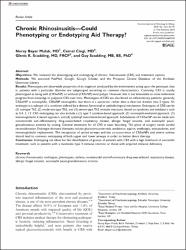Chronic Rhinosinusitis—Could Phenotyping or Endotyping Aid Therapy?
Citation
Bayar Muluk, N., Cingi, C., Scadding, G. K., & Scadding, G. (2019). Chronic Rhinosinusitis-Could Phenotyping or Endotyping Aid Therapy?. American journal of rhinology & allergy, 33(1), 83–93.Abstract
Objectives: We reviewed the phenotyping and endotyping of chronic rhinosinusitis (CRS) and treatment options. Methods: We searched PubMed, Google, Google Scholar, and the Proquest Central Database of the Kırıkkale University Library. Results: Phenotypes are observable properties of an organism produced by the environment acting upon the genotype, that is, patients with a particular disorder are subgrouped according to common characteristics. Currently, CRS is usually phenotyped as being with (CRSwNP) or without (CRSsNP) nasal polyps. However, this is not immutable as some individuals progress from nonpolyp to polypoid CRS over time. Phenotypes of CRS are also based on inflammatory patterns, generally CRSwNP is eosinophilic, CRSsNP neutrophilic; but there is a spectrum, rather than a clear-cut division into 2 types. An endotype is a subtype of a condition defined by a distinct functional or pathobiological mechanism. Endotypes of CRS can be (1) nontype Th2, (2) moderate type Th2, and (3) severe type Th2 immune reactions, based on cytokines and mediators such as IL4, 5, 13. CRS endotyping can also include a (1) type 2 cytokine-based approach, (2) eosinophil-mediated approach, (3) immunoglobulin E-based approach, and (4) cysteinyl leukotriene-based approach. Subdivisions of CRSwNP can be made into nonsteroidal anti-inflammatory drug-exacerbated respiratory disease, allergic fungal sinusitis, and eosinophil pauci-granulomatous arteritis by testing. General treatment for all CRS is nasal douching. The place of surgery needs careful reconsideration. Endotype-directed therapies include glucocorticosteroids, antibiotics, aspirin, antifungals, anticytokines, and immunoglobulin replacement. The recognition of united airways and the co-occurrence of CRSwNPs and severe asthma should lead to common endotyping of both upper and lower airways in order to better direct therapy. Conclusion: Endotyping can allow for the identification of groups of patients with CRS with a high likelihood of successful treatment, such as patients with a moderate type 2 immune reaction or those with acquired immune deficiency. © The Author(s) 2018.
















